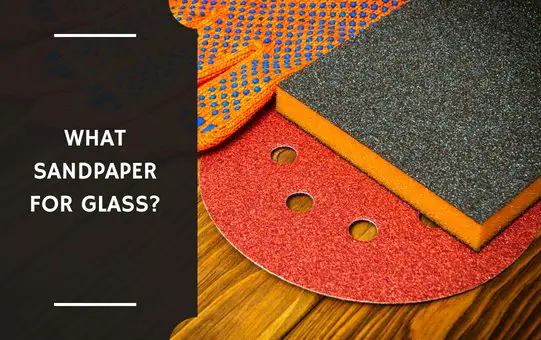When it comes to sanding glass, it’s important to use the right type of sandpaper to achieve the desired finish.
Whether you’re smoothing out rough edges or creating a frosted effect, there are specific sandpaper types that work best.
What Sandpaper for Glass?
There is no one definitive answer to this question, as the best sandpaper for glass depends on the type of glass being worked on and the user’s personal preferences.
In this article, we’ll explore the different types of sandpaper for glass and how to use them effectively.
See Also: Why Does My Sandpaper Keep Falling Off?
What Sandpaper for Glass? – Guide
When it comes to sanding glass, you need to use specialized sandpaper that is designed for this purpose.
Using the wrong type of sandpaper can result in scratches, chipping, or even cracking the glass surface. Here is a guide on what sandpaper to use for glass:
How to Choose the Right Sandpaper for Glass?
When it comes to sandpaper, there are a few things to keep in mind when trying to figure out which one is best for glass.
The type of glass, the smoothness of the surface, and the desired finish are all important factors to consider.
Understanding Sandpaper Grits
Before we dive into the specific types of sandpaper for glass, it’s important to understand sandpaper grits.
Sandpaper grit refers to the number of abrasive particles per square inch on the sandpaper’s surface.
The higher the number, the finer the grit. Finer grits are used for smoothing and polishing, while coarser grits are used for removing material and shaping.

Types
There are many types of sandpaper that you can use for glass. Each type has its own set of benefits and drawbacks.
- Wet-Dry Sandpaper
- Diamond Sandpaper
- Silicon carbide sandpaper
- Garnet sandpaper
- Aluminum oxide sandpaper
Wet-Dry Sandpaper
Wet-dry sandpaper is a versatile type of sandpaper that can be used for a variety of surfaces, including glass.
As the name suggests, it can be used wet or dry, depending on the application. Wet sanding is often used for glass to prevent the glass from overheating and cracking during the sanding process.
Wet-dry sandpaper comes in a variety of grits, but for glass, it’s recommended to use a finer grit such as 400 or 600.
Wet-dry sandpaper can be used by hand or with a sanding block to achieve a smooth finish on glass edges or surfaces.
Silicon Carbide Sandpaper
Silicon carbide sandpaper is a popular choice for sanding glass because it’s hard and durable, making it effective for removing material from glass surfaces.
It’s also waterproof, making it suitable for wet sanding. Silicon carbide sandpaper is available in a variety of grits, but for glass, it’s recommended to use grit between 80 and 220. This type of sandpaper is ideal for shaping and smoothing glass edges.
Diamond Sandpaper
Diamond sandpaper is the most expensive type of sandpaper but it’s also the most effective for smoothing and polishing glass surfaces.
Diamond sandpaper is made by coating the sandpaper with diamond particles, making it extremely hard and durable.
It’s also waterproof, making it suitable for wet sanding. Diamond sandpaper comes in a variety of grits, but for glass, it’s recommended to use grit between 1500 and 3000.
Diamond sandpaper can be used to polish the glass to a high shine or create a frosted effect on the glass surface.
Garnet sandpaper
Garnet sandpaper is a good choice for most types of glass. It cuts quickly and leaves behind a smooth finish. However, it can be expensive and is not as durable as other options.
Aluminum oxide sandpaper
Aluminum oxide sandpaper is less expensive than garnet paper and is more durable. However, it doesn’t cut as quickly and may leave behind a rougher finish.
No matter which type of sandpaper you choose, be sure to test it on a small area first to make sure it won’t damage the surface of your project before proceeding.

LANNEY Sandpaper For Glass
Achieve a flawless finish with the LANNEY sandpaper assortment!
From 120 to 2500 grit, this waterproof set comes with a sanding block sander for precision.
Perfect for polishing wood, metal, glass, and cars.
How to Use Sandpaper on Glass Effectively?
To use sandpaper on glass effectively, you will need to purchase the correct type of sandpaper.
Glass sandpaper is available in different grits or degrees of coarseness. The higher the grit number, the finer the sandpaper. For most applications, medium-grit sandpaper, such as 120-grit, will be sufficient.
If you are working with a very delicate piece of glass, or if you simply want a smoother finish, you can use fine-grit sandpaper, such as 200-grit.
Keep in mind that the finer the grit, the more difficult it will be to remove any scratches or imperfections.
When using sandpaper on glass, always wet the surface first. This will help to prevent the sandpaper from clogging and will also make it easier to move across the surface of the glass.
Use circular motions when sanding, and apply moderate pressure. Be sure to evenly cover the entire area that you are working on.
After you have finished sanding, wipe away any dust with a clean cloth and inspect your work.
If necessary, repeat the process with a finer grit sandpaper until you are satisfied with the results.
What Are the Benefits of Using Sandpaper on Glass?
Sandpaper is a versatile tool that can be used on a variety of surfaces, including glass. When sanding glass, sandpaper can help to create a smooth, even surface.
It can also be used to remove scratches or other blemishes from the surface of the glass.
Sandpaper is available in a variety of grits, or degrees of coarseness. The higher the grit number, the finer the sandpaper. For most applications on glass, medium-grit sandpaper should suffice.
However, if you are trying to remove deep scratches or other damage from the surface of the glass, you may need to use coarse-grit sandpaper.
When using sandpaper on glass, it is important to work slowly and gently. If you apply too much pressure or move too quickly, you could end up damaging the glass.
What Are the Most Common Mistakes When Using Sandpaper on Glass?
One of the most common mistakes when using sandpaper on glass is not using proper grit.
Glass is a very delicate material, and using sandpaper with too high of grit can easily scratch and damage the surface.
It’s important to start with a very fine grit sandpaper and gradually work your way up to a coarser grit if needed.
Another common mistake is not applying even pressure while sanding. This can also lead to uneven results and scratches on the glass surface.
It’s important to use gentle, even strokes while sanding to avoid damaging the glass.
Finally, another mistake people make when sanding glass is not cleaning off the dust afterward.
Dust from the sandpaper can build up on the glass and cause scratches or other damage.
Always be sure to clean off any dust after sanding before moving on to the next step in your project.
Conclusion
No matter what you decide, sandpaper for glass is an effective tool to help you finish any glass project.
Whether you need to sand something small or large, there is a sandpaper to fit your needs.
With the right sandpaper and a bit of patience, you can achieve an amazing finish on any glass project.
I hope this blog post is helpful for you in understanding what Sandpaper for Glass.
Read Also: What Grit Sandpaper for Wood?
